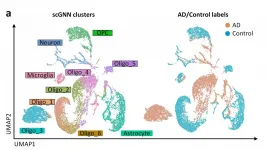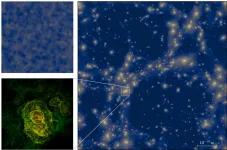A new way to visualize mountains of biological data
Researchers led by the University of Missouri create a new method for analyzing large amounts of biological data to help scientists draw faster conclusions for possible treatments.
2021-03-25
(Press-News.org) Studying genetic material on a cellular level, such as single-cell RNA-sequencing, can provide scientists with a detailed, high-resolution view of biological processes at work. This level of detail helps scientists determine the health of tissues and organs, and better understand the development of diseases such as Alzheimer's that impacts millions of people. However, a lot of data is also generated, and leads to the need for an efficient, easy-to-use way to analyze it.
Now, a team of engineers and scientists from the University of Missouri and the Ohio State University have created a new way to analyze data from single-cell RNA-sequencing by using a computer method called "machine learning." This method uses the power of computers to intelligently analyze large amounts of data and help scientists draw faster conclusions and move to the next stage of the research. Their methodology is detailed in a new paper published by Nature Communications.
"Single cell genetic profiling is on the cutting edge of today's technological advances because it measures how many genes are present and how they are expressed from the level of an individual biological cell," said Dong Xu, a professor in the MU College of Engineering. "At a minimum, there could be tens of thousands of cells being analyzed in this manner, so there ends up being a huge amount of data collected. Currently, determining conclusions from this type of data can be challenging because a lot of data must be filtered through in order to find what researchers are looking for. So, we applied one of the newest machine-learning methods to tackle this problem -- a graph neural network."
After computers intelligently analyze the data through a machine learning process, the graph neural network then takes the results and creates a visual representation of the data to help easily identify patterns. The graph is made up of dots -- each dot representative of a cell -- and similar types of cells are color coded for easy recognition. Xu said precision medicine is a good example of how single-cell RNA-sequencing can be used.
"With this data, scientists can study the interactions between cells within the micro-environment of a cancerous tissue, or watch the T-cells, B-cells and immune cells all try to attack the cancerous cells," Xu said. "Therefore, in cases where a person has a strong immune system, and the cancer hasn't fully developed yet, we can learn how the cancer can possibly be killed at an early stage, and we have our results sooner because of machine learning, which leads us to a viable treatment faster."
Xu believes this is a great example of how engineers and biologists can work together to study problems or issues in biology. He hopes this method can be used by biologists as a new tool to help solve complex biological questions, such as a possible treatment for Alzheimer's disease.
INFORMATION:
The study, "scGNN is a novel graph neural network framework for single-cell RNA-Seq analyses," was published in Nature Communications. Funding was provided by awards (R35-GM126985 and R01-GM131399) from the National Institute of General Medical Sciences of the National Institutes of Health.
Editor's Note: Xu has joint appointments in the Electrical Engineering and Computer Science Department, the Christopher S. Bond Life Sciences Center and the Informatics Institute at the University of Missouri. Juexin Wang, a research scientist at MU, is also the first author on the study. Collaborators at the Ohio State University include Qin Ma, Anjun Ma and Hongjun Fu.
[Attachments] See images for this press release:

ELSE PRESS RELEASES FROM THIS DATE:
2021-03-25
The very first moments of the Universe can be reconstructed mathematically even though they cannot be observed directly. Physicists from the Universities of Göttingen and Auckland (New Zealand) have greatly improved the ability of complex computer simulations to describe this early epoch. They discovered that a complex network of structures can form in the first trillionth of a second after the Big Bang. The behaviour of these objects mimics the distribution of galaxies in today's Universe. In contrast to today, however, these primordial structures are microscopically small. Typical clumps have masses of only a few grams and fit into volumes much smaller than present-day elementary particles. The results of the study have been published ...
2021-03-25
One-third of the Earth's surface is covered by more than 11,000 grass species -- including crops like wheat, corn, rice and sugar cane that account for the bulk of the world's agricultural food production and important biofuels. But grass is so common that few people realize how diverse and important it really is.
Research published today in the journal Nature provides insights that scientists could use not only to improve crop design but also to more accurately model the effects of climate change. It also offers new clues that could help scientists use ...
2021-03-25
Orthopaedic researchers are one step closer to preventing life-long arm and leg deformities from childhood fractures that do not heal properly.
A new study led by the University of South Australia and published in the journal Bone, sheds light on the role that a protein plays in this process.
Lead author Dr Michelle Su says that because children's bones are still growing, an injury to the growth plate can lead to a limb in a shortened position, compared to the unaffected side.
"Cartilage tissue near the ends of long bones is known as the growth plate that is responsible for bone growth in children and, unfortunately, 30 per cent of childhood and teen fractures involve this growth ...
2021-03-25
Researchers have used the evidence of pumice from an underwater volcanic eruption to answer a long-standing mystery about a mass death of migrating seabirds.
New research into the mass death of millions of shearwater birds in 2013 suggests seabirds are eating non-food materials including floating pumice stones, because they are starving, potentially indicating broader health issues for the marine ecosystem.
The research which was led by CSIRO, Australia's national science agency, and QUT, was published in the journal Marine Ecology Progress Series, that examined a 2013 seabird "wreck" in which up to 3 million ...
2021-03-25
A coordinated global effort to reduce the production of greenhouse gas emissions from industry and other sectors may not stop climate change, but Earth has a powerful ally that humans might partner with to achieve carbon neutrality: Mother Nature. An international team of researchers called for the use of natural climate solutions to help "cancel" produced emissions and remove existing emissions as part of a comprehensive plan to keep global warming below 1.5 degrees Celsius -- the point at which damage to human life and livelihoods could become catastrophic, according to the United Nations' Intergovernmental Panel on Climate Change.
The researchers published their invited views on March 24 in ...
2021-03-25
Recently, the team led by Professor WU Changzheng from School of Chemistry and Materials Science from University of Science and Technology of China (USTC) in cooperation with the team led by Prof. WU Hengan from School of Engineering Science, realized the homogenization of surface active sites of heterogeneous catalyst by dissolving the electrocatalytic active metal in molten gallium. The related results have been published on the Nature Catalysis on March 11th.
Due to the existence of various defects and crystal faces, the active components on the surface of heterogeneous catalysts are often in different ...
2021-03-25
Tsukuba, Japan - Physical exercise has long been prescribed as a way to improve the quality of sleep. But now, researchers from Japan have found that even when exercise causes objectively measured changes in sleep quality, these changes may not be subjectively perceptible.
In a study published this month in Scientific Reports, researchers from the University of Tsukuba have revealed that vigorous exercise was able to modulate various sleep parameters associated with improved sleep, without affecting subjective reports regarding sleep quality.
Exercise is ...
2021-03-25
Lugano, Switzerland; Denver, CO, USA, 25 March 2021 - Clinical activity with a second drug inhibiting KRASG12C confirms its role as a therapeutic target in patients with advanced non-small-cell lung cancer (NSCLC) harbouring this mutation, according to results from a study with the KRASG12C inhibitor adagrasib reported at the European Lung Cancer Virtual Congress 2021. (1)
"As we strive to identify the oncogenic driver in more and more of our patients with NSCLC, it becomes critical that we develop therapies that can target these identified oncogenic drivers," said lead author Gregory Riely, from Memorial Sloan Kettering Cancer Center, New York, ...
2021-03-25
For the first time, activation of nuclear receptor coactivator 3 (NCOA3) has been shown to promote the development of melanoma through regulation of ultraviolet radiation (UVR) sensitivity, cell cycle progression and circumvention of the DNA damage response. Results of a pre-clinical study led by Mohammed Kashani-Sabet, M.D., Medical Director of the Cancer Center at Sutter's California Pacific Medical Center (CPMC) in San Francisco, CA were published online today in Cancer Research, a journal of the American Association for Cancer Research.
"Our research suggests a previously unreported mechanism by which NCOA3 regulates the DNA damage response and acts as a potential therapeutic target in melanoma, whereby activation ...
2021-03-25
Durham, NC - Depletion of a certain type of stem cell in the womb lining during pregnancy could be a significant factor behind miscarriage, according to a study released today in STEM CELLS. The study, by researchers at Warwick Medical School, University of Warwick, Coventry, England, reports on how recurrent pregnancy loss is a result of the loss of decidual precursor cells prior to conception.
"This raises the possibility that they can be harnessed to prevent pregnancy disorders," said corresponding author Jan J. Brosens, M.D., Ph.D., professor of obstetrics and gynecology at Warwick Medical School (WMS).
The womb lining - or endometrium - is a ...
LAST 30 PRESS RELEASES:
[Press-News.org] A new way to visualize mountains of biological data
Researchers led by the University of Missouri create a new method for analyzing large amounts of biological data to help scientists draw faster conclusions for possible treatments.





